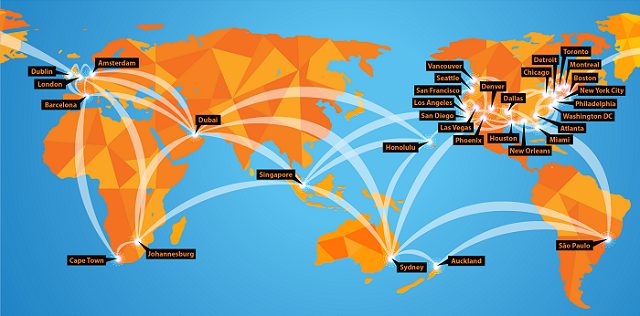Archive for August, 2014
Digital Marketing Conferences
- NORTH AMERICA
- DigiMarCon Cruise
(Orlando, FL, USA) - DigiMarCon East
(New York, NY, USA) - DigiMarCon Mid-Atlantic
(Philadelphia, PA, USA) - DigiMarCon Canada West
(Vancouver, BC, USA) - DigiMarCon Pacific Northwest
(Seattle, WA, USA) - DigiMarCon Canada
(Toronto, ON, Canada) - DigiMarCon Canada East
(Montreal, QC, Canada) - DigiMarCon Rocky Mountains
(Denver, CO, USA) - DigiMarCon Florida
(Miami, FL, USA) - DigiMarCon South
(Houston, TX, USA) - DigiMarCon Silicon Valley
(San Francisco, CA, USA) - DigiMarCon Great Lakes
(Detroit, MI, USA) - DigiMarCon Midwest
(Chicago, IL, USA) - DigiMarCon New England
(Boston, MA, USA) - DigiMarCon California
(San Diego, CA, USA) - DigiMarCon Texas
(Dallas, TX, USA) - DigiMarCon Mid-South
(Nashville, TN, USA) - DigiMarCon South Atlantic
(Charlotte, NC, USA) - DigiMarCon Southeast
(Atlanta, GA, USA) - DigiMarCon Washington DC
(Washington, D.C. USA) - DigiMarCon West
(Los Angeles, CA, USA) - DigiMarCon Las Vegas
(Las Vegas, NV, USA) - DigiMarCon Southwest
(Phoenix, AZ, USA)
- DigiMarCon Cruise
- LATIN AMERICA
- EUROPE
- MIDDLE EAST
- AFRICA
- ASIA PACIFIC
- VIRTUAL
Digital Marketing Blog
- Exploring the Best Social Media Platforms for Social Media Marketing in 2024 April 15, 2024
- Connecting the Dots: Uniting SEO and Social Media Strategies for Stronger Brand Identity April 12, 2024
- The Science of Productivity: How to Get More Done in a Day April 12, 2024
- 20 Common B2B Marketing KPI Examples to Track Performance April 10, 2024























7 Ways Limitations Can Boost Your Content Creation Productivity
By Roger C. Parker
More is always better, right? It would only make sense. More space permits you to share more information. More time permits you to write better. And more options permit you to share your message with greater impact.
Unfortunately, it doesn’t always work out that way, especially in today’s fast-moving content marketing world. Effective content marketing requires getting your message out in a timely and consistent manner. Success requires ongoing productivity — not just isolated moments of brilliance.
The key to boosting your content marketing productivity involves leveraging the Paradox of Limits. Although “more” is usually viewed as an advantage, there are times when “less” is better, achieved by reframing or rescheduling a project or reducing your options.
Just like the supermarket shoppers who, when faced with too many choices end up not buying anything, giving your content marketing team too much freedom can torpedo even the best content marketing ideas and intentions. This is why it’s essential to set limitations on your content creation, to keep you focused on your top priorities — and keep you from getting burned out.
Here, are seven ways to strategically place limitations that can boost your content creation efforts and overall content marketing productivity.
1. Limit the scope of the project
Avoid trying to cover too many ideas or providing too much information about each idea: Trying to write when you haven’t identified the proper balance between the ideas you plan to share and the amount of detail you aim to provide will almost certainly result in indecision and procrastination — if not outright frustration — on the part of a content creator.
Once you identify the right number of ideas and amount of detail you need to get your points across, content creation will appear more manageable and easier to start.
Here are three ways to reduce the scope of a project:
View each content creation project as a balancing act, where you let your marketing goals determine how you will ultimately choose between content that briefly discusses a lot of important points, or content that homes in on a few key points but addresses them in greater detail.
2. Limit the length or size of the project
The bigger the project, the easier it is to put off starting it: This usually results in the exquisite stress of procrastination, which gets worse and worse as deadlines approach. Using less space (i.e., reducing the word count or the length of an audio or video) reduces the intimidation factor caused by worrying about the number of words you have to write to meet expectations.
For example, about 10 years ago, I frequently created one-page print newsletters for my clients, limiting each month’s newsletter to the front and back of a single sheet of paper, (approximately 650 formatted words).
Limiting the word counts in this manner can also pay another important dividend: It helps content creators improve their writing because limited space encourages you to be as concise in communicating ideas as possible.
One of the reasons that blogging a book works so well is that instead of thinking of your project as a 25,000-word document, you view it as a year’s worth of 500-word blog posts or podcasts.
3. Limit the decision-making process
Reducing the number of decisions needing to be made when starting a new project can play an important role in boosting your content marketing productivity. There are two ways you can do this:
A lot has been written about monthly and weekly editorial calendars, but I only recently discovered the importance of sticking to previously-created calendars.
For example, I write a short (250- to 300-word) weekly content marketing article for a client’s newsletter. Because it’s a short project, I enjoy the challenge, and often use it as a “warm-up” writing exercise.
About 6 months ago, however, I made a simple change that resulted in a huge productivity improvement: Previously, I would select the topic for each week’s article by choosing from a short list of randomly assembled topic ideas for the coming month. Choosing the best of the three or four titles would typically spark an inner debate on which topic would be easiest to complete. Now, I just immediately start writing about the topic at the top of the list. Eliminating the need to make a new decision and avoiding the temptation to second-guess myself removed a time-wasting obstacle and made it easier to start writing.
A content template can boost your productivity by guiding you through the writing process. It doesn’t have to be complex — and it doesn’t even have to be digital: In fact, I’ve created a simple three-step content template that can be filled in by hand. You can download it here and print it if you want to give it a try.
The key is to fill in the template as quickly as possible, in the spaces provided. Start by entering the title of your project in the center, and the current date. Then:
Like me, you may find that occasionally writing ideas out by hand offers a refreshing change of pace that makes it easy to generate new ideas and make new connections.
4. Limit the time you make available for working on each project
Buck Howe, a friend of mine from the University of New Hampshire’s Business School, gives the best explanation of this limitation: “Humans are always deadline-driven!” He continued:
You can rethink your approach to content creation by looking for ways to break projects down into small tasks you can complete in short writing sessions, and by trying to get as much done during each session.
Let’s say you have to write a blog post by the end of next week, which typically takes you two hours to do. Instead of trying to schedule a single two-hour writing session, try scheduling three half-hour writing sessions, like this:
What you’ve done is replace a big task with three simpler and less-demanding tasks, each with its own action-stimulating “mini-deadline.” More important, at the end of each session, you’ll enjoy a sense of accomplishment that encourages you to continue creating content. Your times may vary but, over time, the benefits of short deadlines, writing to “beat the clock,” and feelings of accomplishment, will soon add up.
5. Limit options and resources
Limited options and resources can be a powerful productivity builder. It encourages you to start working with what you have available, rather than wasting time trying to figure out which tool or option makes the best sense.
I was not aware of the power of limited resources until I encountered the following paragraph in Twyla Tharp’s The Creative Habit: Learn It and Use It For Life:
I used to bask in the notion that all my obstacles to creative efficiency would vanish if I only had exactly the right resources: my own studio, my own dancers, my own theater; and enough money to pay the dancers all year long and to hire the best collaborators. But I’ve learned that the opposite is true: Limits are a secret blessing, and bounty can be a curse.
Her quote resonated with me because I never could understand why the majority of my best photographs were taken with my camera’s normal (i.e., 50mm) lens even though I was carrying a bagful of wide-angle and telephoto lenses. I realized that limiting my choice of lens immediately engaged me with the scene, encouraging me to make the most of what I had available, rather than interrupting my concentration and switching lenses.
Like Twyla Tharp, I got more done, with less stress, by focusing on what I could do, rather than getting distracted by stressful “what if” decisions.
So, look for other ways to limit your options. Focus on what you can do right now — maximizing the effectiveness of every idea and every word — rather than wishing you had Malcolm Gladwell’s team of researchers or an unlimited web design and programming budget.
More important, save something for later! Resist the urge to add unnecessary complexity, which delays the appearance of your project. On-time delivery of your message may require less research, fewer examples, fewer graphics, and fewer quotations. Focusing on what you do have available can pave the way for spending more time developing your ideas and making the most out of every word.
6. Limit distractions and interruptions
Today, multitasking is an accepted (and often expected) work habit. However, experts like Daniel Goleman, a leading neuroscientist and bestselling author, refer to multitasking as “the bane of efficiency.” In his latest book, Focus: The Hidden Driver of Excellence, Goleman describes how multitasking involves switching the working part of your brain from your primary task to the interruption. His research into how the brain works reminds us that, after an interruption, “It can take 10 to 15 minutes to regain full focus.”
There are several ways you can reduce distractions and interruptions:
These days, no one has enough time. However, with a little effort, you should be able to carve out the distraction-free time necessary to boost your content marketing productivity.
7. Limit your expectations
The more you inflate the importance of a single article, blog post, or white paper, the harder it often becomes to start and complete the content creation process. Performance anxiety based on unreasonably high expectations can torpedo productivity before a project even starts.
The cure for unreasonably high expectations is to view each content marketing project as a step in the right direction, rather than a “silver bullet” to annihilate the competition and lead to a brighter future.
You don’t have to be perfect the first time — there will always be opportunities to expand on your first development of an idea, to readdress and restate your ideas, and to repurpose or reformat them for different audiences and types of learners. For example, Al Ries and Jack Trout didn’t start by writing The Positioning Era. They started with an article, adapted it into a speech, and built their business from there.
View every project as part of a process, rather than an all-or-nothing event. This eliminates the potential to become paralyzed in pursuit of perfection, freeing you to move forward and explore the possibilities.
How do you leverage the power of limits?
Do any of these ideas sound familiar, or resonate with you? How could you use these ideas to enhance your content marketing productivity? Share your experiences, questions, and suggestions below, as comments!
Our agenda for Content Marketing World 2014 is bursting at the seams with great insights and processes that will help you create content more successfully and productively. Register today!
Cover image by Alejandro Escamilla via Unsplash
Category: Content Creation, Productivity
#AskGaryVee Episode 4: Personal Branding and Brett Favre
By Gary Vaynerchuk
In this episode I talk about the importance of my wife, my health, and the fact that Brett Favre had a brief stint as a NY Jet. I also ask the most important question of all: Are you actually bringing value to your consumers?!
_
Welcome to The #AskGaryVee Show, where I answer your questions about marketing, social media, and entrepreneurship. Want to get on the show? Tweet me your question with #AskGaryVee!
LINKS:
My Instagram: https://instagram.com/garyvee
SUBSCRIBE: https://youtube.com/garyvaynerchuk
TIMESTAMPS:
0:36 – For social media is it better to self brand or establish a brand?
1:37 – How important is it that your significant other share your entrepreneurial vision?
3:41 – What’s the most common mistake founders make building a consumer focused business?
5:26 – Whats the biggest lesson you’ve learned this year?
6:28 Whats the best advice you can give salespeople in the social media/digital world age?
Category: Uncategorized, *, askgaryvee, family, health, youtube
The Hubcast #2: Inbound Conference Tips, New Email Tools and More
By George Thomas
The Hubcast Podcast Episode 002
Welcome back to The Hubcast folks! As mentioned last week, this will be a weekly podcast all about HubSpot news, tips, and tricks. Please also note the extensive show notes below including some new HubSpot video tutorials created by George Thomas.
Show Notes:
Inbound 2014
Insider’s Guide To Inbound
The “Insider’s Guide To Inbound” is a great place to start whether you have or haven’t registered for this year’s Inbound event. You can easily get to know the speakers and what they might be bringing to the table this year.
Also, you have to check out the Networking 101 section. I find this a funny piece to the Insider’s Guide. Most of us are business owners, marketers, or in sales, so if we don’t know how to network effectively yet, Inbound might not help change our future. Okay, I know I’m being a little tough on that point but I think you know what I’m saying!
One part I really do love is the advice in the first-timers section. I remember my first Inbound event – it was crazy, scary, and awesome all rolled up into one. Where do I go, who’s in charge, what’s next, how do I network… : ) However, I survived and so will you with this great advice.
View the Insider’s Guide To Inbound: https://www.inbound.com/inbound14/insiders-guide
Other Items for Inbound 2014
There will be a ton of learning opportunities. As a matter of fact, there are 170 + sessions consisting of Bold Talks, Inbound Stories, a entire Partners Track, Keynote speakers and more.
If you haven’t registered yet, you absolutelyshould. The experience, the learning and the relationships you build are well worth the investment. Check out the 2013 recap video to see what others say about Inbound. Also check out the second video – it’s the 2012 event starter. This will give you a glimpse into how cool Inbound can be. Crank it up and get all sorts of excited for Inbound 2014!
Inbound 2012 Intro
See other presenters coming to Inbound 2014
Visit the Inbound website
HubSpot Tips & Tricks
Setting up your custom contact properties: Basic Tip
Talk about being able to hand pick what properties show up when you first look at contacts. It’s also available on a per user basis and offers easy drag and drop functionality. For a deep dive explanation check out the video tutorial on our TSL Learning YouTube channel.
View the tutorial here
Slicing up your database for social influencers: Advanced Tip
Advanced: Talk about slicing and dicing your contact database. This covers how you can determine who the influencers are. The creation of HubSpot hack is explained. Also addressed: Smart Lists, Automated Email, & Workflows.
View the tutorial here
HubSpot Strategy
In this episode, Marcus will discuss the importance of identifying the 4 different types of content producers within your company’s organization. We also talk about a recent interview we did with Krista Kotrla, the Senior Vice President of Marketing from Block Imaging.
Watch the interview here
HubSpot Updates
(Each week on the Hubcast, George and Marcus will be looking at HubSpot’s newest updates to their software. And in this particular episode, we’ll be discussing 3 of their newest updates)
Email Link Resolver
Have you ever received an email, clicked on a link, and it goes to a dead page? What do you do next? Delete the email, of course. This new update will ensure that silly mistakes like including the wrong URL aren’t made. It is easy to forget to check links, but a broken link could make or break the success of the email.
You can now confirm that links in your email work before sending them out in HubSpot. If some of your links go to dead pages, we will warn you before you confirm your send.
After you click “Send email,” the following message will pop up letting you know that some of your links don’t work. Note that it will still allow you to send the email anyway, but now customers will be aware that there is a mistake in their email.
Advanced Contact Search
We’ve added the ability to quickly and easily search your Contacts database by adding criteria to your search, more specifically searching by list membership and contact properties. Besides seeing the count of contacts, the table will update to reflect who those contacts are. Also, if you decide that the number of contacts is interesting enough to do some marketing around, you can create a smart list with the same criteria right from there.
Perform Bulk Actions for a Set of Cotacts
You can now perform an action, such as “delete”, “add to list” and “enroll in workflow” on multiple contacts at once in both the Contacts and Lists tool. Being able to do bulk actions on Contacts saves you time, and it also allows you to further segment out Contacts in Lists with the ability select only a few Contacts from a List for an action.
HubSpot Wishlist
Compendium-ish for Insourcing: Marcus shares his thoughts on how adding some Compendium-ish features for Insourcing into the HubSpot software would make it killer.
Adding internal links to my blog post: When adding links to your blog post it should bring up site pages links. Why can’t I get to my blog article links! There should be a better way HubSpot.
Cool HubSpot & Inbound Tweets
Content isn’t just for attracting clients, it’s also for retaining them #marketing #inboundlearning pic.twitter.com/xpiZ9rHxdL
— Emily Maxie (@emilymaxie) July 22, 2014
I love all the @HubSpotSupport reps equally, but today John is my favorite! #hubspotting
— Juli Durante (@realjulid) August 4, 2014
HubSpot Question of the Week (answered in this episode)
Arlean asks: If I’m a solopreneur, Does HubSpot make sense for me?
Yes, no, maybe so? It really depends on you, your, business and several other factors. We do share an example of a soloprenueur who is crushing it with HubSpot.
Watch the Smarter Finance USA interview here
If you’d like a HubSpot strategy or tool question answered in a future episode, email us at [email protected] .
Where else can you find the Hubcast Podcast:
Category: Motivational/Inspirational
Content Marketing Personalization: When and How to Use It
By Ann Gynn
Personalization is the process of targeting content to individuals based on one or more of the following: who they are; where they are; when, why, and how they access content; and what device they use to access it, according to Scott P. Abel of The Content Wrangler.
Nearly all B2B organizations (95 percent) make some attempt to segment their content based on their audience, according to CMI’s 2014 B2B Content Marketing research report. The top five ways cited include industry trends, profiles of individual decision-makers, company characteristics, stage in buying cycle, and personalized content preferences.
Yet, personalization is difficult to do in content marketing, says Rebecca Lieb of Altimeter Group. “Content marketing tends to be both longer-form and much less automated than other types of personalized digital marketing, such as email and banner ads.”
There’s also the question of whether the returns from content personalization are worth the tremendous effort it can require. For example, Bruce McDuffee, Interim Content Director at Boeing Digital Aviation and a marketing consultant at Knowledge Marketing for Industry, feels that developing personalized content for every one of your audience personas may be a needlessly redundant exercise:
“Fundamentally, the firm that has a need you can fulfill will rally around the particular need. The need is the need no matter if it is viewed by the technician, the director, the CEO, the CFO, or the purchasing manager. By focusing more on the general needs of your target audience and creating content around that need, you will be more efficient and more effective,” he says.
Given the complexity of the issue and its best practices, it’s no surprise that many marketers are still struggling with how to apply content personalization effectively. To help provide a bit of guidance, we asked some of CMI’s blog contributors, Online Training instructors, and Content Marketing World speakers to share their favorite tips for applying content personalization successfully. Following are their words of advice:
Secure information on individuals, be systematic
Content marketers must have access to information about individuals, not persona groups. It requires content and technology. And, it cannot be done effectively without the adoption of a repeatable, systematic approach. A component content management system that can be connected to other data sources is required to automate personalization efforts and to manage the effort efficiently. —Scott P. Abel, Content Marketing Strategist, The Content Wrangler, Inc. | @scottabel
Monitor what’s popular
When distributing content to your audience, send snippets of content with links to further details. Use your marketing automation tool to monitor what your audience is interested in and personalize further communication based on this.
You also can track if your subscribers visit your website and what pages they visit. Then you can automatically trigger personalized emails based on pages they have visited. —Ian Cleary, Social Media Tools Guy, RazorSocial | @iancleary
Don’t go overboard
Approach content personalization with care. You don’t want your audience to think that your marketing is creepy because it knows too much about them. Balance this against just plastering customer names on information that can be sent to anyone in the phone book.
Invest in quality content that provides your key segments with the five content marketing types every customer seeks: product information, answers to their questions, details on how to use your product, styling insights, and customer ratings and reviews. —Heidi Cohen, President, Riverside Marketing Strategies | @heidicohen
Go small, then grow your efforts
Large-scale personalization takes technology. Companies are now able to target super specific audiences with Facebook ads. Shop Local does this and it’s pretty amazing how specific the targets are.
Small-scale personalization takes work. But it’s also effective, especially for B2B companies that need a lower volume of higher value leads. Come up with any reason to do personalized outreach to a few hundred contacts, and give it a try. It could be a survey, an event, or any other reason to reach out.
You’ll get blisters on your fingers from writing hundreds of personal messages, but those reconnections are golden. This kind of “brute-force” marketing is so difficult, only a tiny percentage of marketers will do it. —Andy Crestodina, Principal, Strategic Director, Orbit Media | @crestodina
Take it step by step
Starting with intelligent segmentation — by discipline, vertical or geography — is a good way in. Moving to behavior-triggered content is a logical next step. Going for full-blown, dynamic personalization is a lot to take on from a standing start. —Doug Kessler, Co-Founder and Creative Director, Velocity Partners | @dougkessler
Curate more than create
While much of the conversation is about creating personalized content, it’s often easier and more useful to curate content on a personalized basis. Piece together what you already have in an email digest so each recipient gets the most relevant content based on his or her preferences.
Here’s an easy way to get started: Allow email list subscribers to subscribe to a particular email newsletter that features select content from only one category of your blog. If you see success, you can get more granular by allowing users to select multiple categories, topics, and authors that they want to follow and receive personalized email digests (although part two may require some engineering). —Pawan Deshpande, Founder and CEO, Curata | @TweetsFromPawan
Understand your audience
What it boils down to with content personalization is knowing your audience. It’s critical for content marketers to understand whom they’re communicating with and what type of content their audience wants to consume. Once that understanding is there, personalization can be applied through different content mediums. —Sunil Rajaraman, Co-founder and CEO, Scripted | @subes01
Be human
Personalization implies knowing your customers personally. To do this well requires acquiring a deep understanding of your buyers. Most efforts fail when personalization is treated as a profiling exercise as opposed to achieving human-centered understanding.
Tips include:
Continuously iterate until you have deep understanding —Tony Zambito, Leading Authority Buyer Persona | @tonyzambito
Looking for more guidance on incorporating content personalization into your marketing efforts? You won’t want to miss Content Marketing World 2014, September 8–11, 2014. Register today!
Cover image by Coley Christine Catalano, via Unsplash
Category: Content Marketing World, Industry News and Trends, Understanding Your Audience